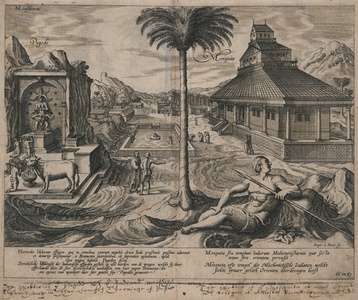| Method | Copper engraving |
| Artist | Baptista van Doetechum after Jan Huygen van Linschoten |
| Published | IHVLinschoten. Bapt. à Doet. fe. [Cornelis Claesz. Amsterdam, c.1596-1638] |
| Dimensions | Image 250 x 322 mm, Sheet 285 x 338 mm |
| Notes |
An illustration of places of worship in India, from Jan Huygen van Linschoten's celebrated Itinerario, one of the most influential travel narratives of the Dutch golden age. The plate shows a pagoda and a mosque in either side of an open plaza, in the centre of a small Indian town. The scene is divided neatly in two by a large central palm tree, under which a figure at rest reclines against a rock, dressed only in loincloth and close fitting cap and holding a long spear in his left hand. On the left hand side of the scene, a large pagoda is built into the hillside, with a very large murti enclosed in a domed niche. Worshippers kneel before the figure, while another devotee burns incense upon a large brazier at the top of the pagoda's stairs. A bull stands beside him. The deity represented in the niche is described as a 'horrible idol' in the commentary below, but the large face on the figure's abdomen is perhaps a crude attempt at representing Jagannath, or simply an imaginative rendering of something 'pagan' or 'heathen' for van Linschoten's contemporary western audiences. On the opposite side of the scene, the mosque is a fairly conventional arcaded building, with groups of figures in Islamic dress preparing to wash in a large ablution pool in the square outside. Latin and Dutch descriptive text below the image reads: 'Horrendae Idolorum effigies, quae in omnibus viarum angulis obvia Indi prostrati passim adorant / et donariis prosequuntur, a Bramenis sacerdotibus, ob sapientiae opinionem, apud / illos magni habitis, Pagodes dicta. / Mesquita seu templum Indorum Mahometistarum quae secta totum fere, orientem pervasit.' 'Scrickelicke beeltdenisse der Indiaensche affgoden gestelt op alle hoecken van de weegen welcke sin haer / offerhande doen en seer devoetelicken aenbidden van haer papen Bramenes (die / om opinie van wysheyt daer seer geacht sinn) Pagodes genaemt. / Mesquita ofte tempel der Machometische Indianen welcke seckte bynaer geheel Orienten doordrongen heest.' Baptista van Doetechum (fl.1583-1611) was a Dutch engraver and publisher, and a member of the van Doetechum family of printmakers. The son of Joannes van Doetechum the Elder (1530-1605), he was trained alongside his brothers Joannes the Younger, and Peter by his father and his uncle, Lucas. Active in Amsterdam, Haarlem, and Deventer, he is best known for engraving plates for Linschoten's Itinerario. Jan Huygen van Linschoten (1563-1611) was a Dutch adventurer, author, and merchant, best known for his role in breaking the Portuguese monopoly in the East Indies through his publication of formerly secret navigational and trade information. Born in Haarlem and raised in Enkhuizen, Linschoten left his native Holland for Spain when young, seeking a mercantile career alongside his older brothers in Spain. Following the Spanish occupation of Portugal, he took a position in the colony of Goa, where he documented local life and, crucially, gained access to Portuguese documents, which he copied and published upon his return to Amsterdam. His cooperation with the publisher Cornelis Claesz led to the production of illustrated narratives of the Barentz voyages, his time in the East Indies, and, most famously, the Itinerario, which was republished multiple times in Dutch, Latin, English, German, and French for almost half a century. Condition: Central vertical fold, as issued. Trimmed to image within platemark along left margin, though with old remargining. Old repaired tears and punctures to central fold, bottom right margins, and top left corner of sheet. Uniform time toning to sheet. Four lines of Dutch manuscript annotation in old hand to bottom margin. |
| Framing | unmounted |
| Price | £375.00 |
| Stock ID | 52623 |

